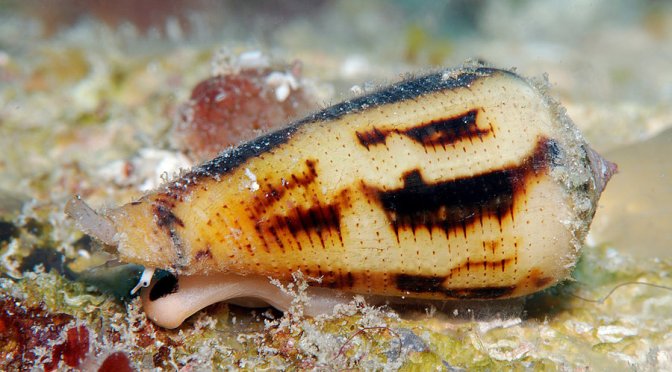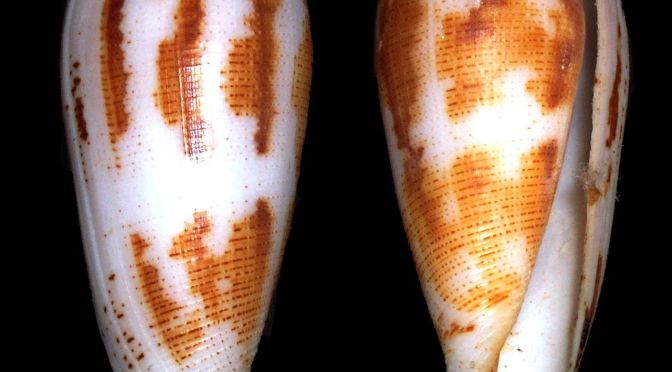Dear Pain Matters blog readers,
For some pain sufferers, pain relief may be offered (in part or in full) by a component of the venom of an ocean-dwelling cone snail called Conus magus.
Before continuing, I would like to take a moment to celebrate the beauty, power, and energy (while also respecting the dangers) of our oceans with all its amazing creatures (including, of course, deadly cone snails). I took this photo from BELOW the ocean waves (while snorkelling yesterday).
ZICONOTIDE (PRIALT) AND SEVERE PAIN
Today’s blog post is on Ziconotide (Prialt). Ziconotide is the synthetic equivalent of a naturally-occurring conopeptide called SNX-111 (or omega-conotoxin MVIIA), a component of the venom of the marine cone snail, Conus magus.
Ziconotide, a novel non-opioid drug, can be used to treat patients with severe chronic pain. It works by selectively and potently blocking the neuronal N-type calcium channel.
Some patients with severe chronic pain may receive significant pain relief from Ziconotide, either as sole treatment (monotherapy) or with other treatments. Ziconotide is able to maintain its analgesic effects for month(s), even after a single infusion treatment.
Ziconotide treatment does not result in tolerance, dependence, nor respiratory depression (unlike opioids). However, there can be adverse effects, especially if dosages are too high, or titrated too quickly (see below).
SUCCESSFUL CASE STUDIES INVOLVING ZICONOTIDE (PRIALT) AND SEVERE PAIN
(1) Severe Intractable Deafferentation Pain Plus Phantom Limb Pain –
A 43-year old male patient suffered (quoting) ‘refractory, severe deafferentation pain’ and phantom limb pain for 23 years, following brachial plexus avulsion and consequent amputation.
Following administration of SNX-111 (Ziconotide) via continuous intrathecal infusion via a cervical catheter, this patient had complete pain relief as well as (quoting) ‘elimination of hyperesthesia and allodynia‘.
Complete pain relief was still provided to this patient even after dosages were reduced to eliminate side effects. Thus, SNX-111 (Ziconotide) may offer potent pain relief for both malignant and nonmalignant pain conditions (Brose et al, 1997).
(2) Three (3) Nerve Pain Patients and Ziconotide Infusion –
The 1st patient, with chronic complex regional pain syndrome (CRPS) in the leg, received a single Ziconotide infusion treatment. This resulted in temporary and complete pain relief. (There were adverse effects, however.)
The 2nd patient (with painful lumbar radiculitis) received complete (albeit temporary) pain relief following a test dose of Ziconotide infusion. (There were also side effects.)
The 3rd patient, with persistent bilateral leg and foot nerve pain due to AIDS and related drug therapy, obtained significant pain relief following long-term continuous intrathecal infusion (Wermeling et al, 2006).
(3) Ziconotide in a 16-year-old Male With CRPS in Both Legs –
A 16-year-old boy with CRPS in both legs was given Ziconotide for 3 years. Pain was reduced at 6 weeks, and a normal gait was achieved at 7 months. The patient reported NIL pain after 3 years of Ziconotide therapy. Side effects included urinary retention and depression (Webster, 2005).
(4) Ziconotide in a 17-year-old Female With Chronic CRPS in Right Lower Leg (Initiated by an Ankle Sprain at 13) –
A 17-year-old girl, who was wheelchair-bound due to chronic CRPS in her right lower leg, was given Ziconotide (and other medications) via intrathecal catheter. As dosages were increased, the swelling in her leg and foot decreased. At greater dosages, pain levels further decreased and the ‘desquamating skin’ receded toward her right foot. At times, the edema disappeared completely.
As dosages were further increased, most of her skin scales had disappeared and her foot appeared pink. Foot movement was regained, as was her quality of sleep that now included a bed cover. By now, she had also progressed from a wheelchair to crutches.
Further months of Ziconotide therapy brought her VAS Pain Score down to 4 (from 8, pre-Ziconotide). By now, ambulation and function was greatly improved, with little or no allodynia nor hyperalgesia.
Significant side effects were not observed, and this was attributed to a slow titration of Ziconotide (Stanton-Hicks et al; 2006).
(5) Ziconotide for 7 CRPS Patients –
Five (5) of 7 CRPS patients had (quoting) ‘substantial improvement in pain, edema, skin abnormalities, and/or mobility with ziconotide therapy’.
In fact, 2 patients had complete pain relief and as such, discontinued Ziconotide treatment altogether.
A 3rd patient had significantly reduced edema as well as decreased skin trophic changes, following Ziconotide infusion.
Adverse events (including depression, anxiety, hallucinations, and urinary retention) were managed via dose reductions/discontinuation, or otherwise (Kapural et al, 2009).
DRAWBACKS/ADVERSE EFFECTS OF ZICONOTIDE (PRIALT)
Several drawbacks and possible adverse effects must be noted including:
– Ziconotide requires intrathecal administration.
NB A properly performed trial of ziconotide infusion should always be done first before consideration is made whether to surgically implant an intrathecal device on a permanent basis, or not. This trial phase is absolutely necessary to ascertain whether a patient will obtain pain relief from ziconotide in the first place (Knight et al, 2007);
and
– There is a risk of one or more adverse effects including dizziness, nausea, ataxia, abnormal gait, headache, abnormal sensations, nystagmus (involuntary eye movement), and/or confusion.
To minimise adverse effects while also maximising pain relief, initial dosages should be low, titrated slowly, and gradually increased as necessary. It may a month (or more) to achieve a fine balance between minimal adverse effects and maximal pain relief (Webster, 2005).
Wishing all pain patients hope, inspiration, and less pain.
Sabina Walker
REFERENCES
SUCCESSFUL CASE STUDIES INVOLVING ZICONOTIDE (PRIALT) AND SEVERE PAIN
(1) Brose et al; Use of intrathecal SNX-111, a novel, N-type, voltage-sensitive, calcium channel blocker, in the management of intractable brachial plexus avulsion pain; Clin J Pain (Sep 1997);13(3):256-9.
http://www.ncbi.nlm.nih.gov/pubmed/9303259
(2) Wermeling et al; Ziconotide Infusion for Severe Chronic Pain: Case Series of Patients With Neuropathic Pain; Pharmacotherapy (Mar 2006); 26(3):395-402.
http://www.ncbi.nlm.nih.gov/pubmed/16503720
(3) Webster; Ziconotide in Complex Regional Pain Syndrome (2005)
http://www.rsds.org/Research_Articles/Ziconotide.htm
(4) Stanton-Hicks et al; An Effective Treatment of Severe Complex Regional Pain Syndrome Type 1 in a Child Using High Doses of Intrathecal Ziconotide; J Pain Symp Man (Dec 2006); 32(6):509-11.
doi:10.1016/j.jpainsymman.2006.08.002
Click to access J_Pain_Symp_Man_2006_32_6_pg509.pdf
(5) Kapural et al; Intrathecal ziconotide for complex regional pain syndrome: seven case reports; Pain Pract (Jul-Aug 2009); 9(4):296-303.
doi: 10.1111/j.1533-2500.2009.00289.x.
http://www.ncbi.nlm.nih.gov/pubmed/19500276
(6) Smith, Deer; Safety and efficacy of intrathecal ziconotide in the management of severe chronic pain; Therapeutics and Clinical Risk Management (Jun 2009); 5(3):521–534.
http://www.ncbi.nlm.nih.gov/pubmed/19707262
(7) Caraway et al; Intrathecal Therapy Trials with Ziconotide – A Trialing Protocol Before Initiation of Long-Term Ziconotide Intrathecal Therapy is Presented.
http://www.practicalpainmanagement.com/treatments/interventional/pumps/intrathecal-therapy-trials-ziconotide
MORE ON ZICONOTIDE (PRIALT)
(8) Knight et al; Implantable Intrathecal Pumps for Chronic Pain: Highlights and Updates; Croat Med J (Feb 2007); 48(1):22-34.
http://www.ncbi.nlm.nih.gov/pmc/articles/PMC2080496/
(9) Miljanich; Ziconotide: Neuronal calcium channel blocker for treating severe chronic pain. Curr Med Chem (2004); 11:3029–3040.
doi: 10.2174/0929867043363884.
http://www.ncbi.nlm.nih.gov/pubmed/15578997
(10) Bowersox, Luther; Pharmacotherapeutic potential of omega-conotoxin MVIIA (SNX-111), an N-type neuronal calcium channel blocker found in the venom of Conus magus. Toxicon (Nov 1998); 36(11), 1651–1658.
(11) Rauck et al; Intrathecal Ziconotide for Neuropathic Pain: A Review; Pain Practice (2009); 9:327–337.
doi:10.1111/j.1533-2500.2009.00303.x
http://onlinelibrary.wiley.com/doi/10.1111/j.1533-2500.2009.00303.x/abstract
CONOTOXINS IN GENERAL
(12) Holmes, David; Conotoxins: how a deadly snail could help ease pain; The Lancet Neurology (Sept 2014); 13(9):867-868.
doi:10.1016/S1474-4422(14)70183-8
http://download.thelancet.com/pdfs/journals/laneur/PIIS1474442214701838.pdf?id=gaa2FpnFy-oV877zjnrMu
(13) Blog post by another blogger, ‘Baldscientist’ –
Magnificent Conotoxins – Expanded (27 July 2014)
http://baldscientist.wordpress.com/2014/07/27/magnificent-conotoxins-expanded/
The blog post by ‘Baldscientist’ includes these References:
(13A) Brady, Baell, Norton; Strategies for the development of conotoxins as new therapeutic leads; Mar Drugs (Jul 2013); 11(7): 2293–2313.
doi: 10.3390/md11072293
http://www.ncbi.nlm.nih.gov/pmc/articles/PMC3736424/
(13B) Essack, Bajic, Archer; Conotoxins that confer therapeutic possibilities. Mar Drugs (2012); 10(6):1244-65.
doi:10.3390/md10061244
http://www.mdpi.com/1660-3397/10/6/1244/htm
 Source: Russo et al, 2015
Source: Russo et al, 2015 Source: Russo et al, 2015
Source: Russo et al, 2015

